Diagrams of nuclear warheads
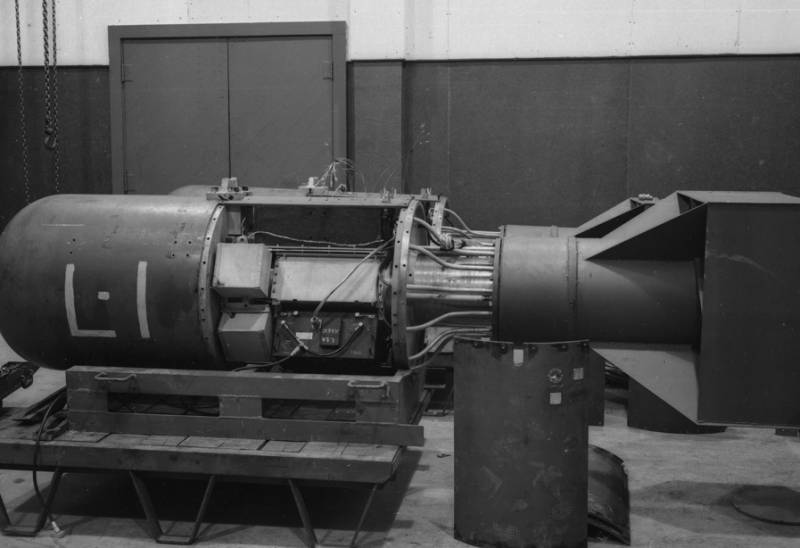
The first mass-produced US nuclear bomb - Little Man. The hull cover is removed, elements of the gun barrel with the main charge are visible. Photo by the US Department of Defense
In the forties of the XX century. scientists from leading countries developed the first samples of nuclear weapons. Creating a workable and combat-ready ammunition turned out to be a difficult task. It was necessary to come up with and implement a design that meets several complex requirements. The result of these searches in the future was several different schemes for nuclear weapons and a number of their options. Some of them remained in stories, while others have proven their effectiveness and are still used today.
Cannon scheme
The first nuclear weapon used in a real strike was the American product Little Boy ("Kid"). On August 6, 1945, it was used against the Japanese city of Hiroshima. It was aviation a bomb with a warhead based on 64 kg of uranium with an actual yield of 15-18 kt TNT. To simplify the design and speed up production, the charge was built according to the so-called. cannon or ballistic scheme.
The charge of the cannon circuit had a fairly simple design. It was built in an elongated tubular hull - artillery barrels of sufficient caliber were used in this capacity. Inside the barrel-body, at its ends, two blocks of subcritical uranium-235 were placed. One of them was mobile and equipped with a powder charge: when the ammunition was initiated, this block was literally fired at the second. A source of neutrons could also be provided.

Schematic diagram of the bomb "Kid" gun scheme. The blocks of uranium are marked in red. Graphics Wikimedia Commons
When two blocks were connected, the uranium charge acquired a supercritical mass, which led to the launch of a nuclear chain reaction. A separate neutron source was supposed to increase the reliability of operation. To develop the reaction and increase the power of the explosion, it was necessary to keep the uranium together for the first milliseconds - this task was solved due to the strong barrel and the pressure of the powder gases.
The cannon scheme was simple, but had significant drawbacks. First of all, it is low efficiency. Due to the design features, a significant part of the main charge during the explosion was sprayed into space without having time to react. So, at "Baby" in the reaction, only approx. 1% uranium. In addition, there was a risk of spontaneous detonation of a combat-ready product.
However, in the early stages of the development of nuclear forces, the cannon scheme found application. In the United States, they mastered small-scale production of Little Boy products and assembled 35 such devices. In addition, early nuclear-armed artillery shells were built according to this scheme. With the advent of new and more advanced designs, the cannon scheme has gone down in history.
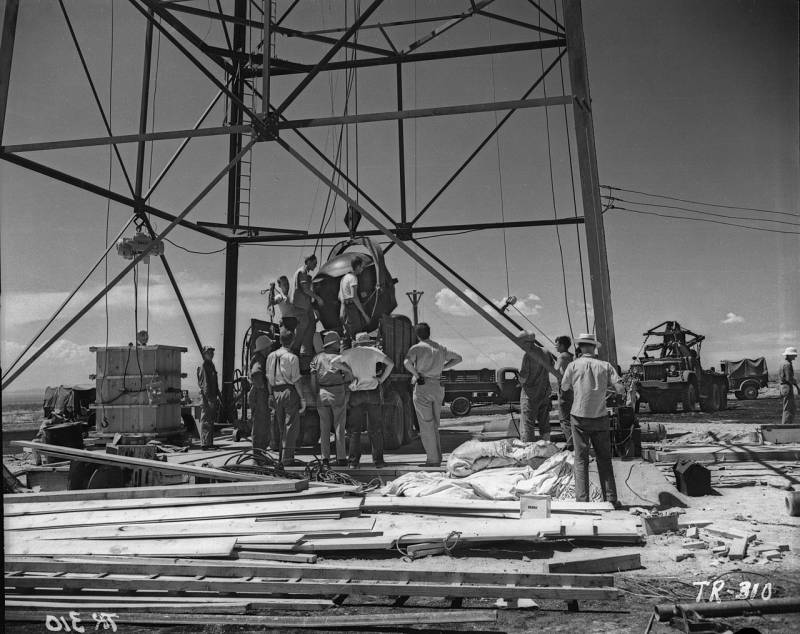
Installation of the Gadget product on a test tower, July 1945. Photo by the US Department of Energy
Squeeze effect
July 16, 1945 - a few weeks before the release of the "Kid" - the world's first test of a nuclear weapon took place at the American test site Alamogordo. An experimental charge with the Gadget code was made on the basis of plutonium-239 and built according to the so-called. implosive scheme. In view of the physical characteristics of plutonium, it did not allow the use of a cannon scheme with a "shot" of one part of the charge into another.
The implosion scheme proposed the use of a spherical plutonium charge-nucleus of subcritical mass. Inside it there was a cavity with a metal source of neutrons to start a nuclear reaction. Outside, the core was covered with several layers of "ordinary" explosive. The resulting sphere was equipped with a large number of separate fuses, evenly distributed over its surface. It also required a control device for the simultaneous, with a deviation of no more than milliseconds, the operation of all fuses.
The simultaneous detonation of the entire conventional charge compresses the core, and also causes the central element to emit neutrons. The pressure from the explosion also ensured that the fissile material was held together during the first moments of the chain reaction.
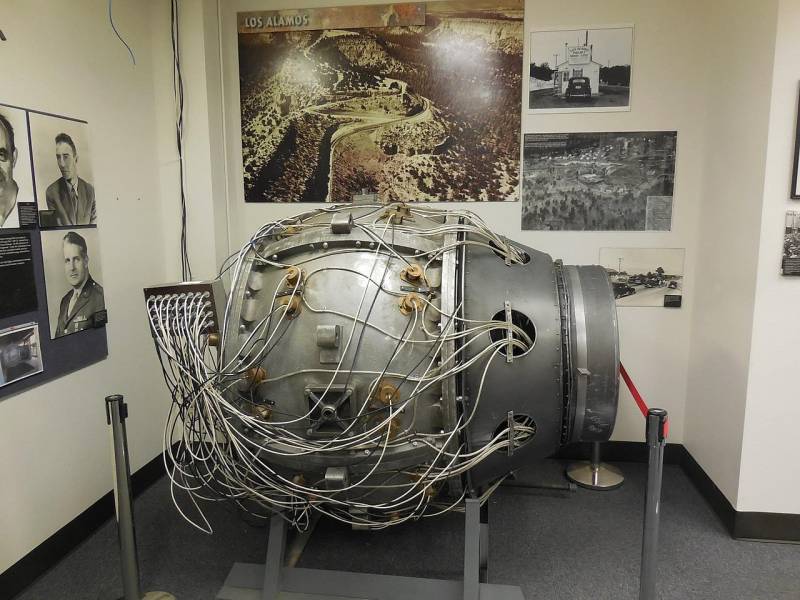
Model of the implosion warhead used in the Gadget and Fat Man items. Numerous fuse control wires are visible. Photo by Wikimedia Commons
The implosion scheme was more complicated than the cannon one, but it was distinguished by greater reliability and efficiency. It was according to this scheme that the plutonium bomb Fat Man (“Fat Man”), dropped in August 1945 on the city of Nagasaki, was built. Later in the United States, new models of implosive charges of different power and in various designs were developed and introduced.
The development of Soviet nuclear weapons began with the implosion scheme. Having gained access to information about American developments, our physicists took into account foreign experience. They abandoned the unsuccessful cannon scheme and immediately began to develop products for the implosion scheme. Early domestic products, starting from the very first RDS-1, were built exactly according to this scheme.
Other countries, already at the stage of the first experiments with nuclear weapons, used precisely the implosion scheme. They also managed to achieve a successful combination of performance, reliability and complexity of production.
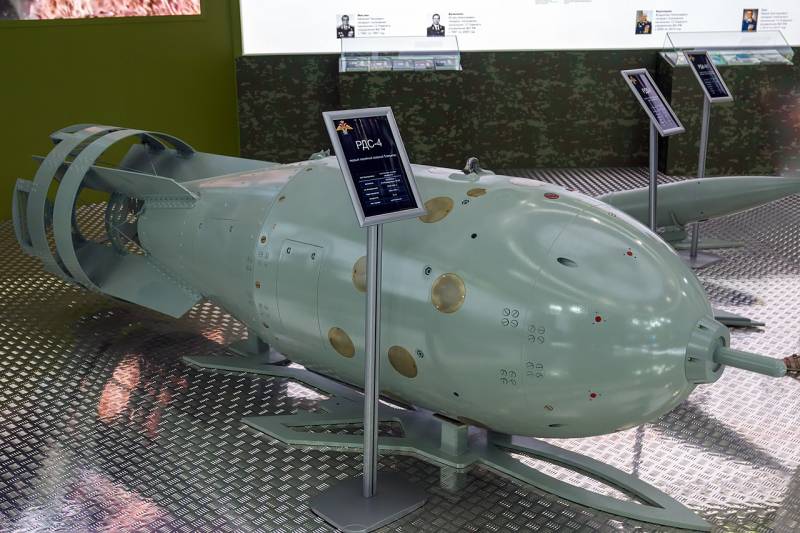
Soviet nuclear bomb RDS-4 of the implosion scheme, adopted for service in 1954. The world's first tactical nuclear weapon. Photo by Wikimedia Commons
Development Options
The implosion scheme with spherical compression had clear advantages over the gun scheme, but was not without drawbacks. First of all, the efficiency remained low - in early samples, no more than 13-15 percent reacted. fissile material. Therefore, the search for new ideas and solutions continued, and some of the new schemes came to implementation in practice. The main focus was on improving the reliability and safety of nuclear devices.
At the end of the forties, the idea of the so-called. nuclear booster. Then similar ideas were studied in other countries. Such a scheme is generally similar to the implosive one, but it used a small amount of thermonuclear fuel - deuterium, tritium or their compounds - as a neutron source. When compressed, this substance produces neutrons with increased energy, which more effectively initiate a chain reaction in the main charge. This increases the efficiency of the charge, and with it the achievable power. In addition, by placing the neutron source in charge immediately before use, it is possible to increase the safety of operation.
In the fifties, a scheme appeared, known as Swan (eng. "Swan"). It received this name because of the cross section of the warhead assembly, reminiscent of the curved necks of swans. The product of such a scheme has a spherical charge of subcritical mass, and the initiating charge of a conventional explosive, which is responsible for compression, has a complex curved shape. The main charge is placed with an offset to the edge of such a shell.
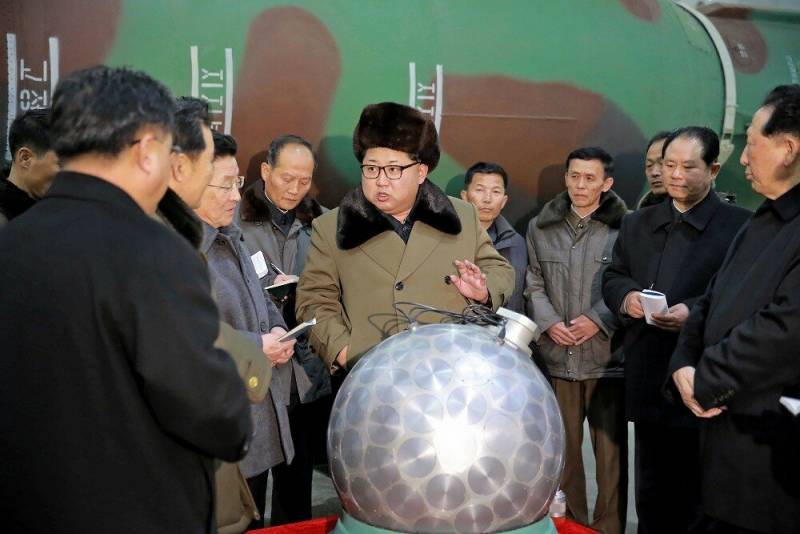
North Korean leader Kim Jong-un inspects a mock-up of a nuclear warhead. Judging by the shape, this is an implosion-type product. Photo by CTAC
Undermining the "normal" charge is carried out using a single fuse, which simplifies the design and eliminates the need to synchronize several similar devices. In this case, the shape of the initiating charge conducts and distributes the shock wave so that the compression of the plutonium sphere occurs in an optimal way. The charge of such a circuit can be equipped with additional fuses: when triggered, they disrupt the passage of the shock wave and prevent a chain reaction from starting.
Fundamentally new technologies
In the forties and fifties, scientists from leading countries developed several basic nuclear charge schemes, as well as a number of their versions with various modifications. On the basis of these ideas, real ammunition was created, which was later adopted for service. However, by the mid-fifties, the process of fundamental development and renewal of nuclear weapons based on decay reached the maximum possible results at that time and began to slow down.
At the same time, full-scale work began on the creation of a new generation of super-powerful weapons - thermonuclear charges based on the synthesis of elements. Over time, all the efforts of scientists and engineers were thrown precisely at the thermonuclear direction. "Conventional" nuclear charges were now considered only as the first stage of a thermonuclear system.
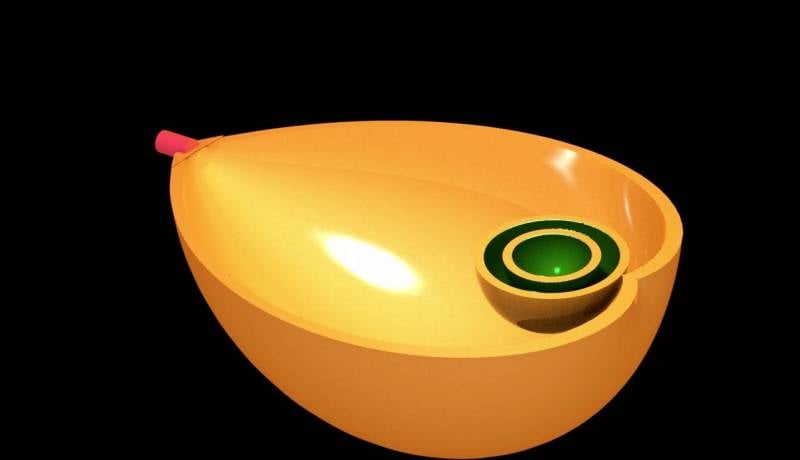
Sectional view of Swan-type ammunition. The plutonium core is marked in green, the only fuse responsible for triggering is marked in red. Graphics Wikimedia Commons
Despite the change in common goals, the development of "conventional" nuclear devices continued, although already without the introduction of fundamentally new solutions and ideas. According to known data, various variants of the implosion scheme were mainly used, meeting the requirements of specific projects. This approach can still be maintained - it is fully consistent with the tasks set and allows you to create samples with the required characteristics.
On a solid foundation
Nuclear weapons appeared and ended up in the arsenals of leading countries in the middle of the last century. At the same time, scientists and designers were looking for and working out various design options for such weapons, which made it possible to increase all the main characteristics. This process was crowned with success - already in the first years of work, all the main schemes and layouts were found and implemented.
The ideas of the middle of the last century in one form or another are still used today. At the same time, the development of technologies and materials that has taken place in recent decades makes it possible to more fully use the potential of long-proposed schemes. As a result, rather old developments are still helping to build and improve the nuclear shield and provide strategic deterrence.
Information